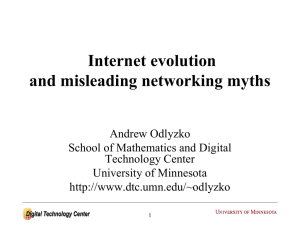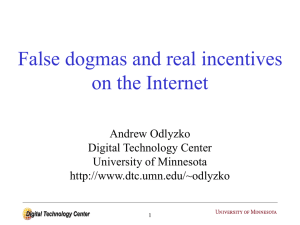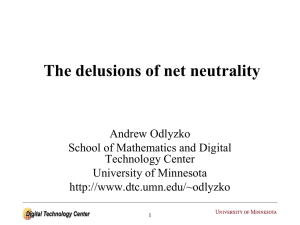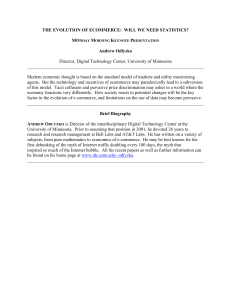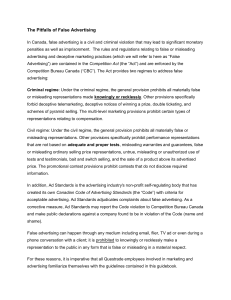Internet economics, Internet evolution, and misleading networking myths Andrew Odlyzko Digital Technology Center
advertisement
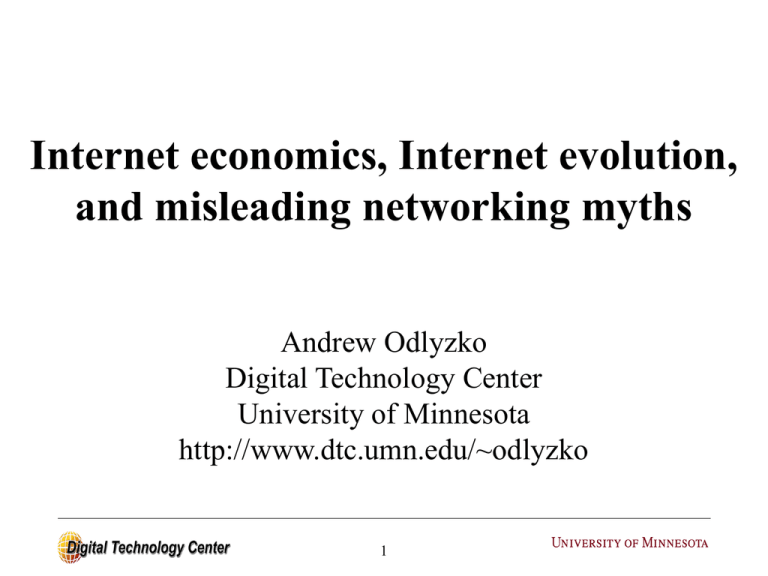
Internet economics, Internet evolution, and misleading networking myths Andrew Odlyzko Digital Technology Center University of Minnesota http://www.dtc.umn.edu/~odlyzko 1 Frequent misplaced bets on technologies: Number of papers per year with ATM or Ethernet in the abstract, data from IEEE Xplore (2004) (estimated values for 2004). Kalevi Kilkki, Sensible design principles for new networks and services, First Monday, Jan. 2005, http://www.firstmonday.org/issues/issue10_1/kilkki 2 Being wrong is not a barrier to success: The goals of the advertising business model do not always correspond to providing quality search to users. ... we expect that adertising funded search engines will be inherently biased towards the advertisers and away from the needs of the consumers. ... But we believe the issue of advertising causes enough mixed incentives that it is crucial to have a competitive search engine that is transparent and in the academic realm. 3 Overwhelming need for flexibility in technology and business plans: The goals of the advertising business model do not always correspond to providing quality search to users. ... we expect that adertising funded search engines will be inherently biased towards the advertisers and away from the needs of the consumers. ... But we believe the issue of advertising causes enough mixed incentives that it is crucial to have a competitive search engine that is transparent and in the academic realm. Sergey Brin and Larry Page, 1998 4 Long-haul is not where the action is: 360networks transatlantic cable Construction cost Sale price $850 M $18 M Annual operating cost $10 M Lit capacity 192 Gb/s Ave. transatlantic Internet traffic (mid-2003) 5 70 Gb/s Misleading dogmas impeding reform and restructuring: • Carriers can develop innovative new services • Content is king • Voice is passe • Streaming real-time multimedia traffic will dominate • There is an urgent need for new “killer apps” • Death of distance • QoS and measured rates 6 Dominant types of communication: business and social, not content, in the past as well as today Thirty years ago you left the city of Assur. You have never made a deposit since, and we have not recovered one shekel of silver from you, but we have never made you feel bad about this. Our tablets have been going to you with caravan after caravan, but no report from you has ever come here. circa 2000 B.C. A fine thing you did! You didn't take me with you to the city! If you don't want to take me with you to Alexandria, I won't write you a letter, I won't talk to you, I won't say Hello to you even. ... A fine thing you did, all right. Big gifts you sent me - chicken feed! They played a trick on me there, the 12th, the day you sailed. Send for me, I beg you. If you don't, I won't eat, I won't drink. There! circa 200 A.D. 7 Human communication: One picture is worth a thousand words 8 Human communication: One picture is worth a thousand words, provided one uses another thousand words to justify the picture. Harold Stark, 1970 9 Key misleading myth: streaming real-time traffic • Little demand for truly real-time traffic • For most traffic, faster-than-real-time transfer wins: – far simpler network – enables new services – takes advantage of growing storage 10 Predictions: • telecom should continue to grow faster than economy (ICT revolution not finished) • core hollowing out • growth likely to be captured by new players • will continue to stumble to success, hobbled by misleading myths 11 Further data, discussions, and speculations in papers and presentation decks at: http://www.dtc.umn.edu/~odlyzko 12
